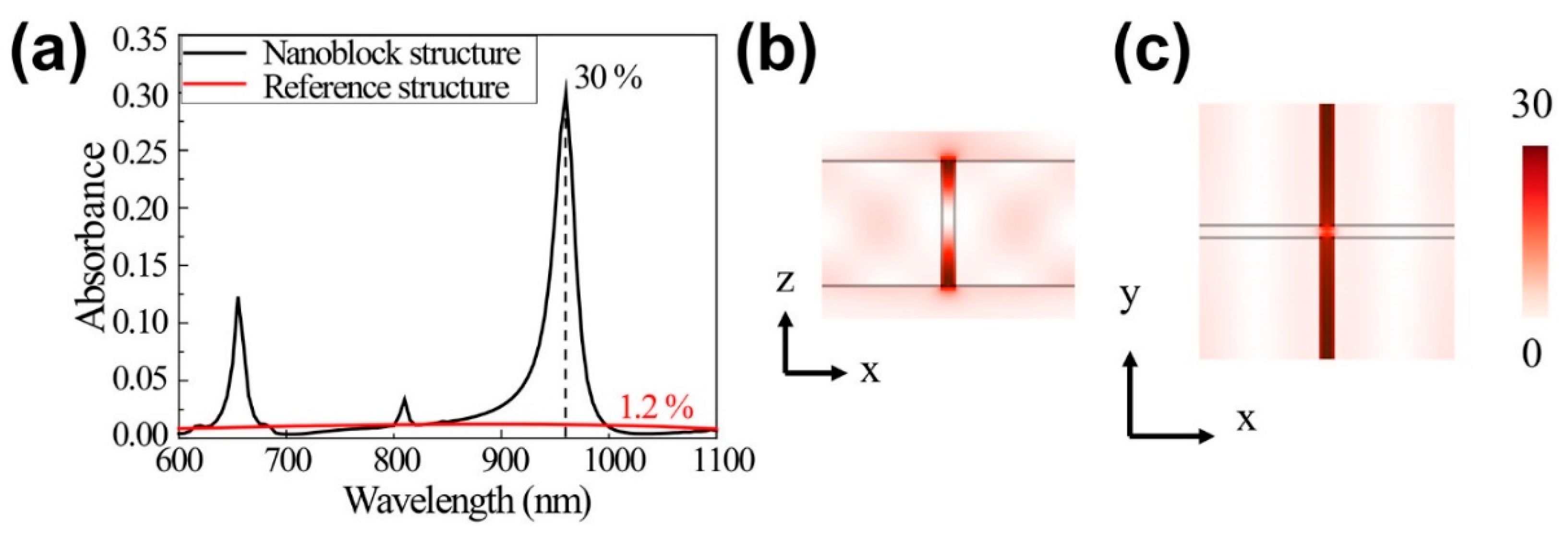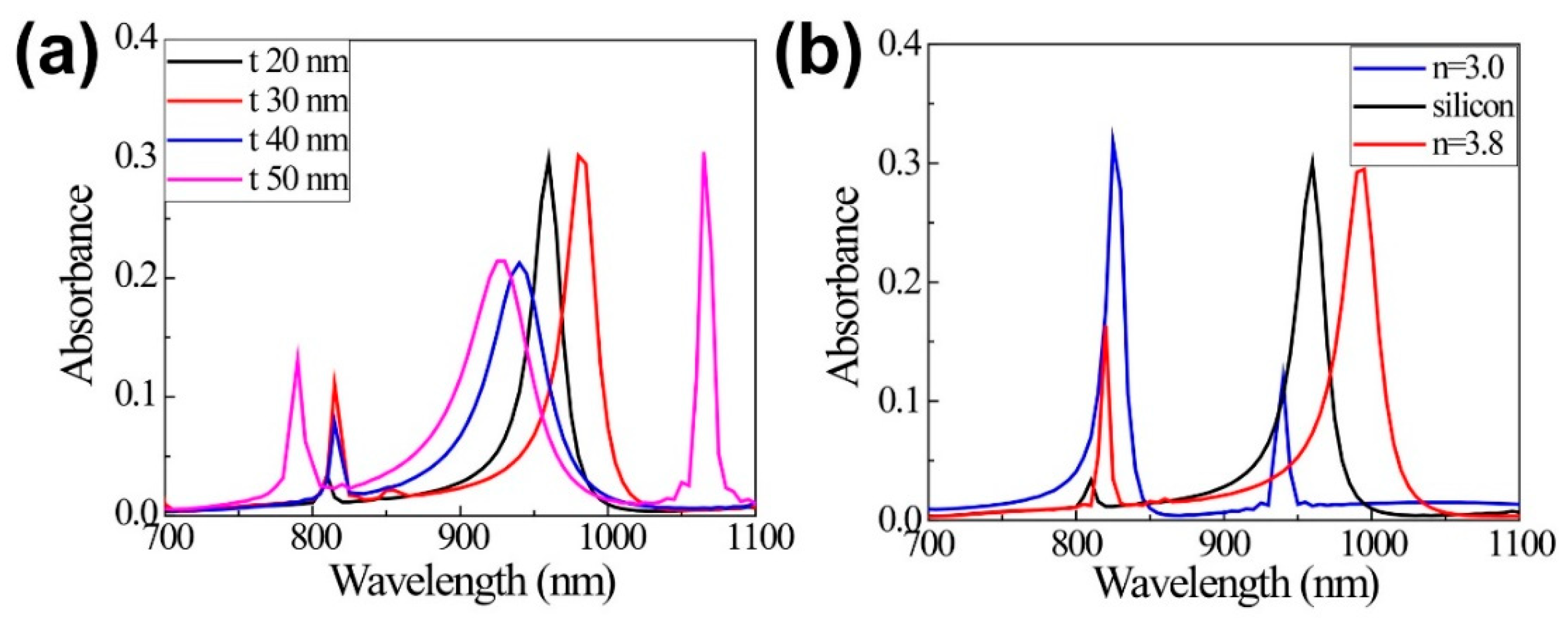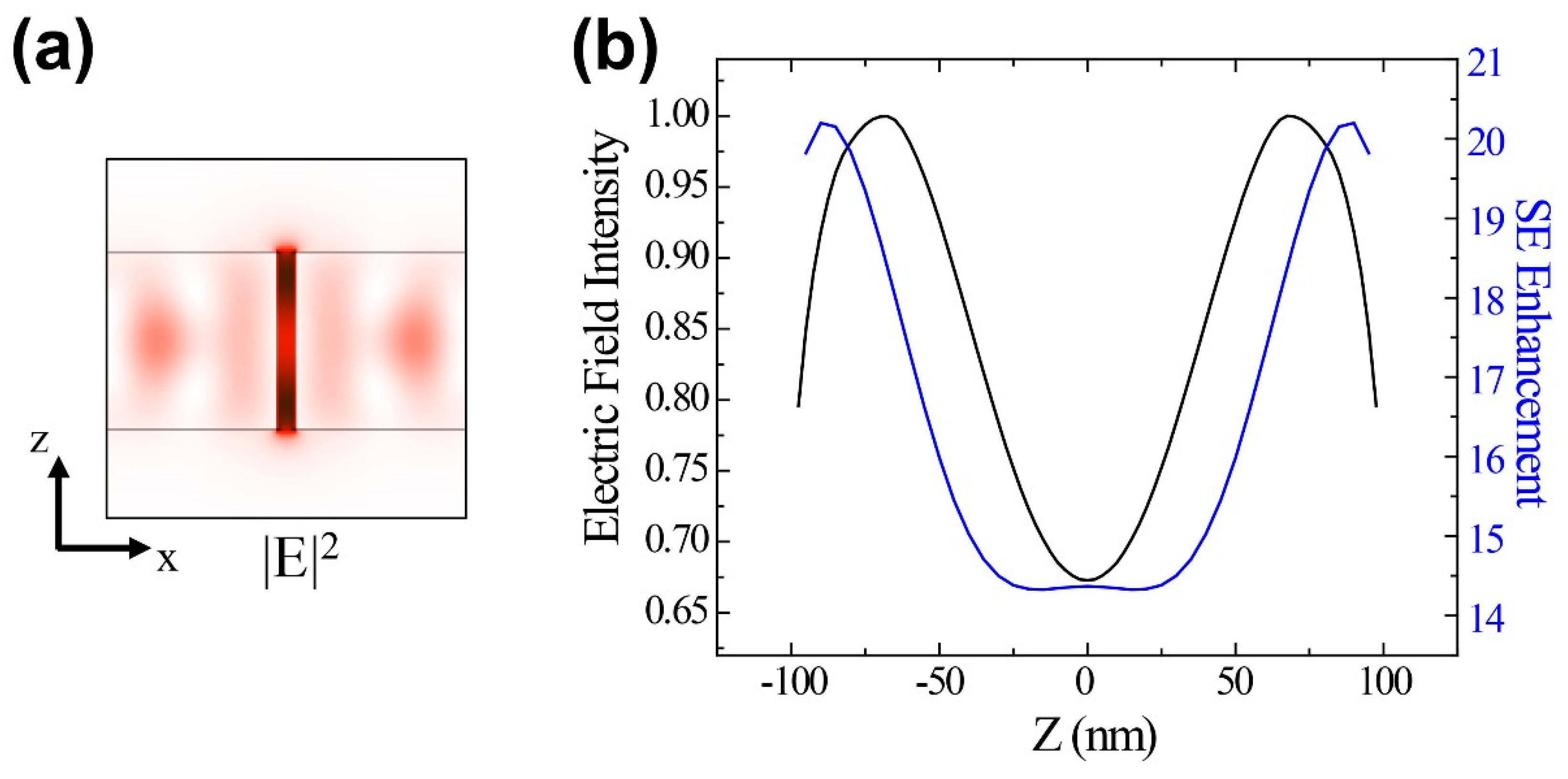Improving Upconversion Efficiency Based on Cross-Patterned Upconversion Material Slot Waveguides on a Silicon Layer
Abstract
1. Introduction
2. Upconversion Material Absorption Enhancement
3. Proposed Upconversion Slot Array Spontaneous Emission Enhancement
4. Conclusions
Author Contributions
Funding
Conflicts of Interest
References
- Nyk, M.; Kumar, R.; Ohulchanskyy, T.Y.; Bergey, E.J.; Prasad, P.N. High Contrast in Vitro and in Vivo Photoluminescence Bioimaging Using Near Infrared to Near Infrared Up-Conversion in Tm3+ and Yb3+ Doped Fluoride Nanophosphors. Nano Lett. 2008, 8, 3834–3838. [Google Scholar] [CrossRef] [PubMed]
- Xiong, L.-Q.; Chen, Z.-G.; Yu, M.-X.; Li, F.-Y.; Liu, C.; Huang, C.-H. Synthesis, characterization, and in vivo targeted imaging of amine-functionalized rare-earth up-converting nanophosphors. Biomaterials 2009, 30, 5592–5600. [Google Scholar] [CrossRef]
- Fang, W.; Wei, Y. Upconversion nanoparticle as a theranostic agent for tumor imaging and therapy. J. Innov. Opt. Health Sci. 2016, 09, 1630006. [Google Scholar] [CrossRef]
- van Sark, W.G.; de Wild, J.; Rath, J.K.; Meijerink, A.; Schropp, R.E. Upconversion in solar cells. Nanoscale Res. Lett. 2013, 8, 81. [Google Scholar] [CrossRef]
- Cheng, Y.Y.; Fückel, B.; MacQueen, R.W.; Khoury, T.; Clady, R.G.C.R.; Schulze, T.F.; Ekins-Daukes, N.J.; Crossley, M.J.; Stannowski, B.; Lips, K.; et al. Improving the light-harvesting of amorphous silicon solar cells with photochemical upconversion. Energy Environ. Sci. 2012, 5, 6953. [Google Scholar] [CrossRef]
- Goldschmidt, J.C.; Fischer, S. Upconversion for photovoltaics—A review of materials, devices and concepts for performance enhancement. Adv. Opt. Mater. 2015, 3, 510–535. [Google Scholar] [CrossRef]
- Lee, K.-T.; Park, J.-H.; Kwon, S.J.; Kwon, H.-K.; Kyhm, J.; Kwak, K.-W.; Jang, H.S.; Kim, S.Y.; Han, J.S.; Lee, S.-H.; et al. Simultaneous Enhancement of Upconversion and Downshifting Luminescence via Plasmonic Structure. Nano Lett. 2015, 15, 2491–2497. [Google Scholar] [CrossRef]
- Schulze, T.F.; Schmidt, T.W. Photochemical upconversion: Present status and prospects for its application to solar energy conversion. Energy Environ. Sci. 2015, 8, 103–125. [Google Scholar] [CrossRef]
- Andrews, D.L.; Curutchet, C.; Scholes, G.D. Resonance energy transfer: Beyond the limits. Laser Photon. Rev. 2011, 5, 114–123. [Google Scholar] [CrossRef]
- Shalav, A.; Richards, B.S.; Trupke, T.; Krämer, K.W.; Güdel, H.U. Application of NaYF4:Er3+ up-converting phosphors for enhanced near-infrared silicon solar cell response. Appl. Phys. Lett. 2005, 86, 013505. [Google Scholar] [CrossRef]
- Zhao, C.; Kong, X.; Liu, X.; Tu, L.; Wu, F.; Zhang, Y.; Liu, K.; Zeng, Q.; Zhang, H. Li+ ion doping: An approach for improving the crystallinity and upconversion emissions of NaYF4:Yb3+, Tm3+ nanoparticles. Nanoscale 2013, 5, 8084–8089. [Google Scholar] [CrossRef] [PubMed]
- Sun, Q.-C.; Mundoor, H.; Ribot, J.C.; Singh, V.; Smalyukh, I.I.; Nagpal, P. Plasmon-Enhanced Energy Transfer for Improved Upconversion of Infrared Radiation in Doped-Lanthanide Nanocrystals. Nano Lett. 2014, 14, 101–106. [Google Scholar] [CrossRef] [PubMed]
- Lee, G.Y.; Jung, K.; Jang, H.S.; Kyhm, J.; Han, I.K.; Park, B.; Ju, H.; Kwon, S.J.; Ko, H. Upconversion luminescence enhancement in plasmonic architecture with random assembly of metal nanodomes. Nanoscale 2016, 8, 2071–2080. [Google Scholar] [CrossRef] [PubMed]
- Park, K.; Jung, K.; Kwon, S.J.; Jang, H.S.; Byun, D.; Han, I.K.; Ko, H. Plasmonic Nanowire-Enhanced Upconversion Luminescence for Anticounterfeit Devices. Adv. Funct. Mater. 2016, 26, 7836–7846. [Google Scholar] [CrossRef]
- Purcell, E.M.; Torrey, H.C.; Pound, R.V. Resonance absorption by nuclear magnetic moments in a solid. Phys. Rev. 1946, 69, 37–38. [Google Scholar] [CrossRef]
- Gérard, J.M.; Gayral, B. Strong Purcell effect for InAs quantum boxes in three-dimensional solid-state microcavities. J. Lightw. Technol. 1999. [Google Scholar] [CrossRef]
- Lee, Y.J.; Moon, K.; Kwon, S.-H. Enhanced Conversion Process in a Sub-wavelength Thin Upconversion Layer by Using Metamaterial Mirror. Plasmonics 2019. [Google Scholar] [CrossRef]
- Moon, K.; Lee, Y.; Hong, S.; Kwon, S.-H.; Moon, K.; Lee, Y.J.; Hong, S.; Kwon, S.-H. Wavelength Conversion Enhancement Achieved by Using Resonance in an Array of Nanocylinders. Appl. Sci. 2017, 7, 1246. [Google Scholar] [CrossRef]
- Saboktakin, M.; Ye, X.; Chettiar, U.K.; Engheta, N.; Murray, C.B.; Kagan, C.R. Plasmonic Enhancement of Nanophosphor Upconversion Luminescence in Au Nanohole Arrays. ACS Nano 2013, 7, 7186–7192. [Google Scholar] [CrossRef]
- Aouani, H.; Rahmani, M.; Navarro-Cía, M.; Maier, S.A. Third-harmonic-upconversion enhancement from a single semiconductor nanoparticle coupled to a plasmonic antenna. Nat. Nanotechnol. 2014, 9, 290. [Google Scholar] [CrossRef] [PubMed]
- Melik-Gaykazyan, E.V.; Shcherbakov, M.R.; Shorokhov, A.S.; Staude, I.; Brener, I.; Neshev, D.N.; Kivshar, Y.S.; Fedyanin, A.A. Third-harmonic generation from Mie-type resonances of isolated all-dielectric nanoparticles. Philos. Trans. R. Soc. A Math. Phys. Eng. Sci. 2017, 375, 20160281. [Google Scholar] [CrossRef] [PubMed]
- Fischer, S.; Goldschmidt, J.C.; Löper, P.; Bauer, G.H.; Brüggemann, R.; Krämer, K.; Biner, D.; Hermle, M.; Glunz, S.W. Enhancement of silicon solar cell efficiency by upconversion: Optical and electrical characterization. J. Appl. Phys. 2010, 108, 044912. [Google Scholar] [CrossRef]
- de Wild, J.; Meijerink, A.; Rath, J.K.; van Sark, W.G.J.H.M.; Schropp, R.E.I. Towards upconversion for amorphous silicon solar cells. Sol. Energy Mater. Sol. Cells 2010, 94, 1919–1922. [Google Scholar] [CrossRef]
- Haase, M.; Schäfer, H. Upconverting Nanoparticles. Angew. Chem. Int. Ed. 2011, 50, 5808–5829. [Google Scholar] [CrossRef] [PubMed]
- Sokolov, V.I.; Zvyagin, A.V.; Igumnov, S.M.; Molchanova, S.I.; Nazarov, M.M.; Nechaev, A.V.; Savelyev, A.G.; Tyutyunov, A.A.; Khaydukov, E.V.; Panchenko, V.Y. Determination of the refractive index of β-NaYF4/Yb3+/Er3+/Tm3+ nanocrystals using spectroscopic refractometry. Opt. Spectrosc. 2015, 118, 609–613. [Google Scholar] [CrossRef]
- Schinke, C.; Christian Peest, P.; Schmidt, J.; Brendel, R.; Bothe, K.; Vogt, M.R.; Kröger, I.; Winter, S.; Schirmacher, A.; Lim, S.; et al. Uncertainty analysis for the coefficient of band-to-band absorption of crystalline silicon. AIP Adv. 2015, 5, 067168. [Google Scholar] [CrossRef]
- Xu, Q.; Almeida, V.R.; Panepucci, R.R.; Lipson, M. Experimental demonstration of guiding and confining light in nanometer-size low-refractive-index material. Opt. Lett. 2004, 29, 1626. [Google Scholar] [CrossRef] [PubMed]
- Feng, N.-N.; Michel, J.; Kimerling, L.C. Optical Field Concentration in Low-Index Waveguides. IEEE J. Quantum Electron. 2006, 42, 883–888. [Google Scholar] [CrossRef]
- Anderson, P.A.; Schmidt, B.S.; Lipson, M. High confinement in silicon slot waveguides with sharp bends. Opt. Express 2006, 14, 9197. [Google Scholar] [CrossRef]
- Giedraityte, Z.; Tuomisto, M.; Lastusaari, M.; Karppinen, M. Three- and Two-Photon NIR-to-Vis (Yb,Er) Upconversion from ALD/MLD-Fabricated Molecular Hybrid Thin Films. ACS Appl. Mater. Interfaces 2018, 10, 8845–8852. [Google Scholar] [CrossRef] [PubMed]
- Park, H.; Yoo, G.Y.; Kim, M.-S.; Kim, K.; Lee, C.; Park, S.; Kim, W. Thin film fabrication of upconversion lanthanide-doped NaYF4 by a sol-gel method and soft lithographical nanopatterning. J. Alloys Compd. 2017, 728, 927–935. [Google Scholar] [CrossRef]
- Wegh, R.; Donker, H.; van Loef, E.V.; Oskam, K.; Meijerink, A. Quantum cutting through downconversion in rare-earth compounds. J. Lumin. 2000, 87–89, 1017–1019. [Google Scholar] [CrossRef]
- Oskam, K.; Wegh, R.; Donker, H.; van Loef, E.V.; Meijerink, A. Downconversion: A new route to visible quantum cutting. J. Alloys Compd. 2000, 300–301, 421–425. [Google Scholar] [CrossRef]
- Richards, B.S. Luminescent layers for enhanced silicon solar cell performance: Down-conversion. Sol. Energy Mater. Sol. Cells 2006, 90, 1189–1207. [Google Scholar] [CrossRef]
- Kozlovsky, W.J.; Nabors, C.D.; Byer, R.L. Efficient second harmonic generation of a diode-laser-pumped CW Nd:YAG laser using monolithic MgO:LiNbO/sub 3/external resonant cavities. IEEE J. Quantum Electron. 1988, 24, 913–919. [Google Scholar] [CrossRef]
- Thyagarajan, K.; Rivier, S.; Lovera, A.; Martin, O.J.F. Enhanced second-harmonic generation from double resonant plasmonic antennae. Opt. Express 2012, 20, 12860. [Google Scholar] [CrossRef] [PubMed]
- Celebrano, M.; Wu, X.; Baselli, M.; Großmann, S.; Biagioni, P.; Locatelli, A.; De Angelis, C.; Cerullo, G.; Osellame, R.; Hecht, B.; et al. Mode matching in multiresonant plasmonic nanoantennas for enhanced second harmonic generation. Nat. Nanotechnol. 2015, 10, 412–417. [Google Scholar] [CrossRef]





| Process | Polarization | UC Slot Array | Reference UC Film | Multiplier |
|---|---|---|---|---|
| Absolute absorption (970 nm) | 0.30 | 0.012 | ×25 | |
| SE enhancement (660 nm) | Ex | 10.36 | 0.99 | ×10.5 |
| Ey | 10.36 | 0.99 | ×10.5 | |
| Ez | 1.9 | 0.24 | ×7.9 | |
| Average SE enhancement | 7.54 | 0.74 | ×9.6 | |
| Wavelength conversion efficiency | ×242.5 |
© 2019 by the authors. Licensee MDPI, Basel, Switzerland. This article is an open access article distributed under the terms and conditions of the Creative Commons Attribution (CC BY) license (http://creativecommons.org/licenses/by/4.0/).
Share and Cite
Kim, Y.; Moon, K.; Lee, Y.J.; Hong, S.; Kwon, S.-H. Improving Upconversion Efficiency Based on Cross-Patterned Upconversion Material Slot Waveguides on a Silicon Layer. Nanomaterials 2019, 9, 520. https://doi.org/10.3390/nano9040520
Kim Y, Moon K, Lee YJ, Hong S, Kwon S-H. Improving Upconversion Efficiency Based on Cross-Patterned Upconversion Material Slot Waveguides on a Silicon Layer. Nanomaterials. 2019; 9(4):520. https://doi.org/10.3390/nano9040520
Chicago/Turabian StyleKim, Youngsoo, Kihwan Moon, Young Jin Lee, Seokhyeon Hong, and Soon-Hong Kwon. 2019. "Improving Upconversion Efficiency Based on Cross-Patterned Upconversion Material Slot Waveguides on a Silicon Layer" Nanomaterials 9, no. 4: 520. https://doi.org/10.3390/nano9040520
APA StyleKim, Y., Moon, K., Lee, Y. J., Hong, S., & Kwon, S.-H. (2019). Improving Upconversion Efficiency Based on Cross-Patterned Upconversion Material Slot Waveguides on a Silicon Layer. Nanomaterials, 9(4), 520. https://doi.org/10.3390/nano9040520






